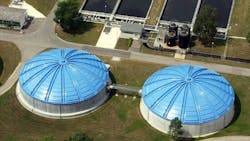Walkable fiberglass-reinforced plastic (FRP) cover systems can boast excellent corrosion resistance and resilience to environmental extremes. These systems can provide a modular design and solve important wastewater issues, helping to cover problems.
C.F. Maier Composites Inc. provides cover systems made of FRP and stainless steel hardware (V4A) instead of alumnium. These materials help to prevent corrosion issues and leave the systems resistant to sulfuric acid. The systems have a durability lasting more than 35 years. Some systems provide integrated nuts, requiring only screws from above for an efficient assembly.
Some areas require cover solutions for very high or low temperatures. With an FRP system and the right materials, covers can be resistant to temperatures ranging from -30 to 180 degrees Fahrenheit. For maintenance, it is important to have a walkable surface for inspections — modern covers feature a non-slip surface to make these inspections safe and easy.
Cover systems can be made almost exclusively from fiber-reinforced plastic. These materials and their advantages have been well known for years: high strength, low weight, chemical resistance, good color ability, ultraviolet light resistance and maximum options for shaping. They also hold extreme resistance to weathering and ageing. Some of these covers are more than 35 years in use without any maintenance.
The FRP components are incorporated in the form of mats, fabrics and non-woven, with strict adherence to the structural analysis and with appropriate safety margins. Often, stainless steel is used for connecting elements. Cut edges, drilled holes and the like are carefully sealed for dependable prevention of moisture penetration into the laminate.
Due to the strength of the material, FRP cover systems are all mostly self-supporting with the ability to span great distances (in excess of 225-foot diameter tanks). The process of hand lamination of parts gives a lot of creative space for customized designs.
Outside the U.S. many covers for wastewater tanks in Europe and Middle East use FRP material in order to cover tanks. It does not matter if the tanks are round, rectangular or have another special shape. Utility maintenance holes, doors, stairs, fences and ladders can be integrated into the overall design of the cover.
Advantages of FRP cover systems
There are many advantages to using cover systems in wastewater applications.
Evaporation. 10% of water is lost through water treatment processing, heat and wind. With covers, the water temperature will be lower than the outside temperature. However, covering tanks with glass fiber instead of aluminum could provide better temperature insulation.
Design. In areas where heavy wind and snow loads are present, a flat cover creates problems compared to a FRP dome or ton construction. In these scenarios, the FRP materials can be implemented to withstand heavy snow and wind loads.
Installation. New assembly concepts allow installing the covers in “one self-supporting piece.” This can be easily done from the top of a tank by a crane without disruption of daily water treatment processing.
Algae. We want to clean our water, but we put more and more chemical components in the water in order to avoid algae blooms. Algae formation accelerates if the water is too warm. Therefore, if the water is protected with an insulated cover system, it can help avoid using chemical treatments. If the water temperature is cooler, it helps more than expected.
Further advantages of covers include reducing greenhouse gas emissions, controlling odor and eliminating volatile organic compounds.
An individually customized FRP cover system can become a solution for many applications throughout the treatment plant facility. FRP materials address many water treatment applications throughout the plant.
There are different cover systems in the marketplace today, such as sandwich panels, foils, aluminum and FRP covers. FRP-systems solve static, corrosion, temperature and many more criteria.
Case study: Jeddah Airport
One good example of a FRP cover system project is a huge wastewater plant at Jeddah Airport in the Kingdom of Saudi Arabia. The airport is becoming more and more important not least due to the enormous and steadily increasing number of passengers.
At the same time, the requirements placed on the infrastructure in the airport region are growing, which is why a large-scale sewage treatment plant near the airport is needed.
It was clear right from the start that the sedimentation tanks had to be covered. Open water surfaces attract birds, which can endanger air traffic, and above all the sight of an open sewage treatment plant was not desirable as the first impression that incoming passengers should receive. A total of some 600,000 square feet had to be covered, spread over many tanks with different shapes and functions.
When the order was placed, the preliminary building work on the tanks was already far advanced, so the existing structures had to be taken into account during planning work on the covers. A further requirement was to keep the air volume underneath the covers of tanks where waste air had to be treated as small as possible.
Finally, the construction concept had to be economically viable and feasible with existing designs and with the manufacturer‘s range of molds. For the eight large circular tanks with over 150 feet diameter, steel lattice beams cross the structure, and underneath FRP wave elements are suspended.
The result was an ornate structure, which was preferred over the originally considered dome solution. The large rectangular areas are all covered with barrel shells as the main beams and with plate elements between them. This results in a visual breaking up of the enormous areas.
For the semi-round closures and also for the circular tanks, the system achieves a uniform appearance with centrally arranged barrel shells. The contractually specified production and delivery deadline of one year was kept.
It would be going too far to list and illustrate every model of cover systems that can be designed and used. This article only suggests the sheer range of what is possible with walkable fiberglass-reinforced plastic cover systems.
About the Author
Torsten Schlegel
Torsten Schlegel is CEO of C.F. Maier Composites Inc.
